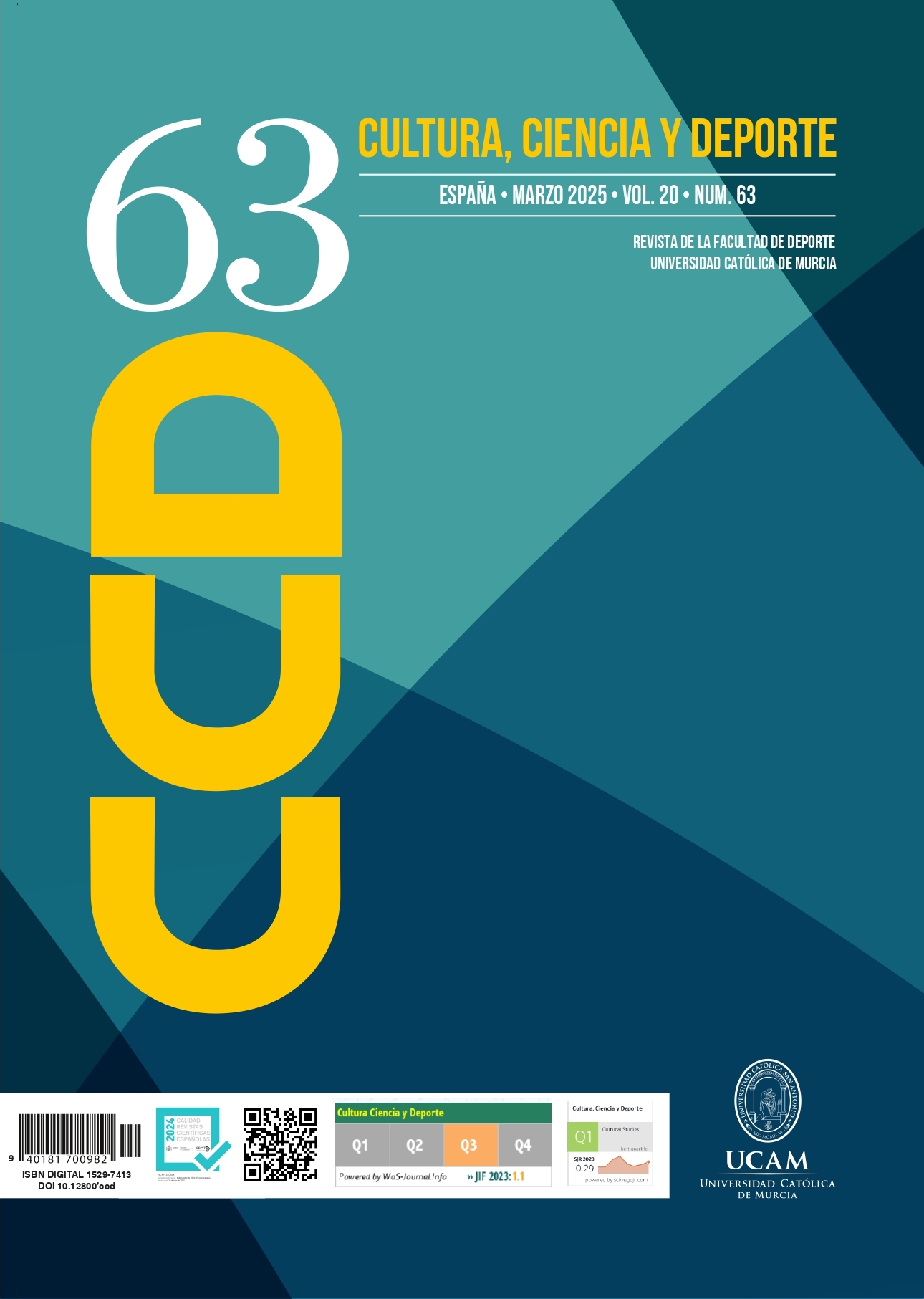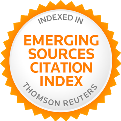Crecimiento Personal Durante el Periodo de Rehabilitación de Lesiones en Deportistas: Una Revisión Sistemática
DOI:
https://doi.org/10.12800/ccd.v20i63.2293Resumen
Se realizó una revisión sistemática con el objetivo de conocer el crecimiento personal durante el periodo de rehabilitación de una lesión deportiva, así como las variables que facilitan el desarrollo de este constructo y las posibles diferencias según el género, edad y gravedad de la lesión. Para ello se realizó una búsqueda de artículos publicados desde 2014 a 2024 en la base de datos Web of Science y Google Académico. Tras el proceso de selección, diez artículos fueron los elegidos para esta revisión sistemática. Tras la revisión de estos diez artículos, se observan unos datos de prevalencia variados de variables que facilitan el desarrollo personal, que van desde la resiliencia, hasta la comunicación positiva con otras personas. Las variables psicológicas más analizadas son el dominio del yo y el autocontrol. No se observaron diferencias respecto al género, edad de los deportistas y nivel de competencia. Los resultados sugieren que el crecimiento personal durante este periodo de rehabilitación es frecuente en los deportistas. No obstante, es necesaria la continua investigación para llegar a conclusiones más certeras.
Citas
Abenza, L. (2010). Psychology and Sports Injuries: an analysis of prevention, rehabilitation and psychological intervention. [Doctoral thesis]. University of Murcia. http://hdl.handle.net/10952/100
Abenza, L., Olmedilla, A., Ortega, E., Ato, M., & García-Mas, A. (2010). Analysis of the Relationship between Mood and Adherence Behaviors in Injured Athletes. Annals of Psychology, 26(1), 159-168. https://doi.org/10.6018/analesps
Andersen, M. B., & Williams, J. M. (1988). A Model of Stress and Athletic Injury: Prediction and Prevention. Journal of Sport and Exercise Psychology, 10, 294-306.
Biñeiro-Cossio, J., Pérez-Ordás, R., Bermejo-Martínez, G., Alcaráz-Iborra, M., & Nuviala, A. (2023). Desarrollo y validación de una escala para evaluar Bienestar Psicológico en Actividad física y deporte: La Escala PWBPA. Retos, 49, 401–407. https://doi.org/10.47197/retos.v49.97623
Brewer, B. W. (2017). Psychological Responses to Sport Injury. Oxford University Press. https://doi.org/10.1093/acrefore/9780190236557.013.172
Brewer, B. W. (2017). Adversarial Growth after Anterior Cruciate Ligament Reconstruction. Journal of Sport Exercise Psychology, 39(2), 134-144. https://doi.org/10.1123/jsep.2016-0210
Bruton, A. (2018). Subjective Distress, Sport Injury-related Growth, Self-efficacy and Wellbeing upon Return to Sport following Injury. Sport and Exercise Psychology Review, 14(2), 23-31. https://pure.roehampton.ac.uk/portal/files/1048979/Subjective_Distress_Sport_Injury_Related_GHrowth_Self_Efficacy_and_Wellbeing.pdf
Cavanna, C., & Chang, C. (2016). Psychological Issues Related to Illness and Injury in Athletes and the Team Physician. Medicine & Science in Sports & Exercise, 49(5), 1043-1054. https://doi.org/10.1249/mss.0000000000001247
Calhoun, L. G., & Tedeschi, R. G. (1998). Posttraumatic growth: Future directions. In R. G. Tedeschi, C. L. Park, & L. G. Calhoun (Eds.), Posttraumatic growth: Theory and research on change in the aftermath of crisis (pp. 215-238). Erlbaum.
Clough, P. J., Earle, K., & Sewell, D. (2002). Mental toughness: The concept and its measurement. In I. Cockerill (Ed.), Solutions in sport psychology (pp. 32-45). Thomson.
Evans, L., Hardy, L., Mitchell, I., & Rees, T. (2008). The Development of a Measure of Psychological Responses to Injury. Journal of Sport Rehabilitation, 17, 21-37. https://doi.org/10.1123/jsr.17.1.21
Flick, U. (2012). Introduction to qualitative research. Ediciones Morata.
Freire, C., Ferradás, M. D. M., Núñez, J. C., & Valle, A. (2022). La consecución del funcionamiento psicológico pleno: La dimensión de crecimiento personal. Papeles del Psicólogo, 43(1), 63-73. https://www.papelesdelpsicologo.es/pdf/2971.pdf
Gómez-Espejo, V. (2020). Influence of Psychological Factors on the Rehabilitation Process of Sports Injuries. Psychological Intervention and Return to Practice. [Doctoral Thesis]. University of Murcia. http://hdl.handle.net/10201/99824
González, L., & Pérez, M. (2015). Development and validation of the Needs Satisfaction Scale (NSS). Journal of Psychology, 30(2), 150-165. https://doi.org/10.1234/rp.2015.0203
Gucciardi, F., & Mallett, C. (2010). Understanding mental toughness and its development in sport. Routledge Handbook of Applied Sport Psychology, 547-556.
Johnson, U., & Ivarsson, A. (2017). Psychosocial factors and sport injuries: Prediction, prevention and future research directions. Current Opinion in Psychology, 16, 89-92. https://doi.org/10.1016/j.copsyc.2017.04.023
Johnson, U., Ivarsson, A., Karlsson, J., Hägglund, M., Waldén, M., & Börjesson, M. (2016). Rehabilitation after first-time anterior cruciate ligament injury and reconstruction in female football players: a study of resilience factors. BMC Sports Science, Medicine and Rehabilitation, 8, 1-8. https://doi.org/10.1186/s13102-016-0046-9
Johnston, L. H., & Carroll, D. (1998). The Context of Emotional Responses to Athletic Injury: A Qualitative Analysis. Journal of Sport Rehabilitation, 7(3), 206-220. https://doi.org/10.1123/jsr.7.3.206
Jones, D. N., & Paulhus, D. L. (2014). Introducing the Short Dark Triad (SD3): A brief measure of dark personality traits. Assessment, 21(1), 28-41. https://doi.org/10.1177/1073191113514105
Joseph, S., & Maltby, J. (2014). Positive functioning inventory: Initial validation of a 12-item self-report measure of well- being. Psychology of Well-Being, 4(1), 15. https://doi.org/10.1186/s13612-014-0015-6
Lebrun, F., & Collins, D. (2017). Is elite sport (really) bad for you? Can we answer the question? Frontiers in Psychology, 8, 324. https://doi.org/10.3389/fpsyg.2017.00324
MacDonald, S. L. (2019). Exploring the Relationship between Stress-Related Growth and Basic Psychological Needs Following Athletic Injuries. [Tesis de maestría]. Western Washington University. https://cedar.wwu.edu/wwuet/891/
McCullough, M. E., Emmons, R. A., & Tsang, J. (2002). The grateful disposition: A conceptual and empirical topography. Journal of Personality and Social Psychology, 82, 112-127. https://doi.org/10.1037//0022-3514.82.1.112
Olmedilla, A., & García-Mas, A. (2009). The global psychological model of sports injuries. Psychological Action, 6(2), 77-91. https://doi.org/10.5944/ap.6.2.223
Olmedilla, A., & García-Mas, A. (2023). Psycholight: Psychological evaluation and intervention protocol for the prevention and rehabilitation of sports injuries. Journal of Psychology Applied to Sport and Physical Exercise, 8(1), 1-11. https://doi.org/10.5093/rpadef2023a4
Páez-Cala, M. L. (2019). Health from the perspective of resilience. Archivos de Medicina (Manizales), 20(1), 203-216. https://doi.org/10.30554/arch-med.20.1.3600.2020
Parent, M. (2021). Associations between Athletes’ Perceptions of Sports Injury Related Growth, Mental Toughness, and the Dark Triad: An Exploratory Study. [Tesis doctoral]. William James College. https://www.proquest.com/openview/652abd1200dcd254fa19842b4b4b785b/1?pq-origsite=gscholar&cbl=18750&diss=y
Park, C. L., Cohen, L. H., & Murch, R. L. (1996). Assessment and prediction of stress-related growth. Journal of Personality, 64(1), 71-105. https://doi.org/10.1111/j.1467-6494.1996.tb00815.x
Pearson, L., & Jones, G. (1992). Emotional Effects of sports injuries: Implications for physiotherapists. Physiotherapy, 78, 762-770. https://doi.org/10.1016/S0031-9406(10)61642-2
Pelster, M., Hofmann, A., Klocke, N., & Warkulat, S. (2021). Dark triad personality traits and selective hedging. Journal of Business Ethics, 182(3), 795-814. https://doi.org/10.1007/s10551-021-04985-z
Podlog, L., Lochbaum, M., & Stevens, T. (2010). Need satisfaction, well-being, and perceived return-to-sport outcomes among injured athletes. Journal of Applied Sport Psychology, 22(2), 167-182. https://doi.org/10.1080/10413201003664665
Puppo Grau, J. (2020). Coping Styles and Sports Performance: A Systematic Review. https://doi.org/10.1007/s10551-021-04985-z
Ramírez, A., Alzate, R., & Lázaro, I. (2002). Psychological effects of sports injury. European Journal of Human Movement, 9, 209-224. https://eurjhm.com/index.php/eurjhm/article/view/87
Rock Ruiz, A. (2019). Psychology and Injury Sportive: one revision. https://repositorio.comillas.edu/jspui/bitstream/11531/31800/1/TFG%20-%20PeAa%20Ruiz%2C%20Andrea.pdf
Roy-Davis, K. (2017). Sport Injury-related Growth: Theory-to-practice. [Tesis doctoral]. University of Roehampton. https://pure.roehampton.ac.uk/portal/en/studentTheses/sport-injury-related-growth
Roy-Davis, K., Wadey, R., & Evans, L. (2017). A Grounded Theory of Growth Related to Sports Injuries. Sport, Exercise, and Performance Psychology, 6(1), 35–52. https://doi.org/10.1037/spy0000080
Rosenberg, M. (1965). Society and the Adolescent Self-image. Princeton University Press.
Rubio, V. J., Quartiroli, A., Podlog, L. W., & Olmedilla, A. (2020). Understanding the dimensions of sport-injury related growth: A DELPHI method approach. PLoS one, 15(6), e0235149. https://doi.org/10.1371/journal.pone.0235149
Salim, J., & Wadey, R. (2018). Can emotional disclosure promote sport injury-related growth? Journal of Applied Sport Psychology, 30(4), 367-387. https://doi.org/10.1080/10413200.2017.1417338
Salim, J., & Wadey, R. (2021). Using Gratitude to Promote Sport Injury-Related Growth. Journal of Applied Sport Psychology, 33(2), 131-150. https://doi.org/10.1080/10413200.2019.1626515
Santi, G., Carraro, A., Mellalieu, S. D., & Wadey, R. (2023). Development and Preliminary Validation of the Sport Injury- related Growth Inventory. International Journal of Sport and Exercise Psychology, 1-26. https://doi.org/10.1080/1612197X.2023.2214141
Schneider, S., Seither, B., Tönges, S., & Schmitt, H. (2006). Sports injuries: population based representative data on incidence, diagnosis, sequelae, and high-risk groups. British Journal of Sports Medicine, 40(4), 334. https://doi.org/10.1136/bjsm.2005.022889
Smith, J., & Jones, M. (2018). Development and validation of the Athlete Psychological Well-Being Inventory (APWBI). Journal of Sport Psychology, 35(2), 123-145. https://doi.org/10.1000/jsp.2018.02.003
Trainor, L. R., Crocker, P. R., Bundon, A., & Ferguson, L. (2020). The rebalancing act: Injured varsity women athletes’ experiences of global and sport psychological well-being. Psychology of Sport and Exercise, 49, 101713. https://doi.org/10.1016/j.psychsport.2020.101713
Truong, L. K., Mosewich, A. D., Holt, C. J., Le, C. Y., Miciak, M., & Whittaker, J. L. (2020). Psychological, social and contextual factors across recovery stages following a sport-related knee injury: a scoping review. British Journal of Sports Medicine, 54(19), 1149-1156. https://doi.org/10.1136/bjsports-2019-101206
Wadey, R., & Evans, L. (2011). Working with injured athletes: Research and practice. In S. Hanton & S. D. Mellalieu (Eds.), Professional practice in sport psychology: A review (pp. 107–133). Routledge.
Wadey, R., Podlog, L., Galli, N., & Mellaliey, S. (2016). Stress-Related Growth Following Sport Injury. Examining the Applicability of the Organismic Valuing Theory. Scandinavian Journal of Medicine & Science in Sports, 26(10), 1132-1139. https://doi.org/10.1111/sms.12579
Wadey, R., Roy-Davis, K., Evans, L., Howells, K., Salim, J., & Diss, C. (2019). Sport Psychology Consultants’ Perspectives on Facilitating Sport Injury-Related Growth. The Sport Psychologist, 33(3), 244–255. https://doi.org/10.1123/tsp.2018-0110
Watson, D., Clark, L. A., & Tellegen, A. (1988). Development and validation of a brief measure of positive and negative affect: The PANAS scales. Journal of Personality and Social Psychology, 54(6), 1063-1070. https://psycnet.apa.org/doi/10.1037/0022-3514.54.6.1063
Wiese-Bjornstal, D. M., Smith, A. M., Shaffer, S. M., & Morrey, M. A. (1998). An integrated model of response to sport injury: Psychological and sociological dynamics. Journal of Applied Sport Psychology, 10(1), 46–69. https://doi.org/10.1080/10413209808406377
World Health Organization. (2001). Physical Activity Section. http://www.who.int/gb
World Health Organization. (2022). Mental Health: Strengthening Our Response. https://www.who.int/es/news-room/fact-sheets/detail/mental-health-strengthening-our-response/?gad_source=1&gclid=Cj0KCQjwqpSwBhClARIsADlZ_TnBN-cUOK9B1rBz-5jEy_fJbgz2bburOnG053W3r-j8fU4huinLz14aAo9sEALw_wcB
Publicado
Cómo citar
Número
Sección
Licencia
Derechos de autor 2025 Creative Commons Attribution License

Esta obra está bajo una licencia internacional Creative Commons Atribución-NoComercial-CompartirIgual 4.0.
Los autores que publican en esta revista están de acuerdo con los siguientes términos:- Los autores conservan los derechos de autor y garantizan a la revista el derecho de ser la primera publicación del trabajo al igual que licenciado bajo una Creative Commons Attribution License que permite a otros compartir el trabajo con un reconocimiento de la autoría del trabajo y la publicación inicial en esta revista.













